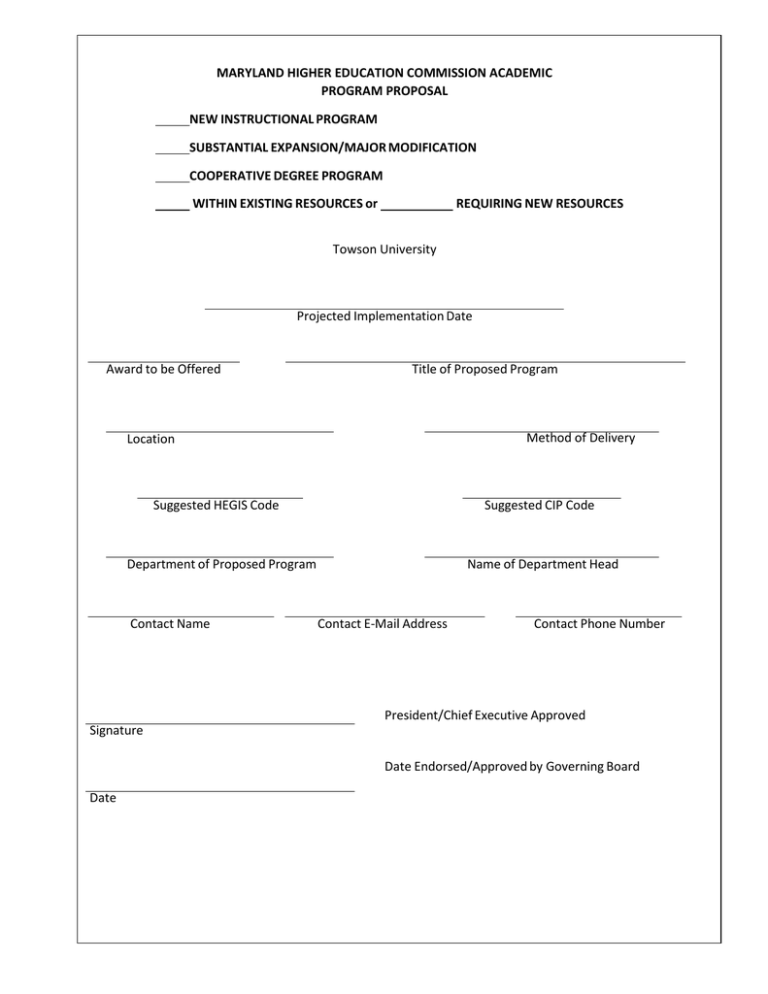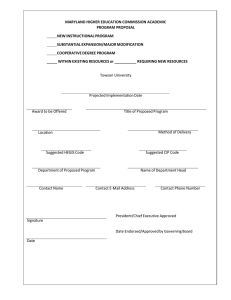Delivery of Exisiting Program to a New Location (off
advertisement

MARYLAND HIGHER EDUCATION COMMISSION ACADEMIC PROGRAM PROPOSAL NEW INSTRUCTIONAL PROGRAM SUBSTANTIAL EXPANSION/MAJOR MODIFICATION COOPERATIVE DEGREE PROGRAM WITHIN EXISTING RESOURCES or REQUIRING NEW RESOURCES Towson University Projected Implementation Date Award to be Offered Title of Proposed Program Method of Delivery Location Suggested HEGIS Code Suggested CIP Code Department of Proposed Program Contact Name Name of Department Head Contact E-Mail Address Contact Phone Number President/Chief Executive Approved Signature Date Endorsed/Approved by Governing Board Date Introduction Provide a description of the program, including each area of concentration (if applicable). Indicate the location delivery for the program, including the method of delivery, e.g. traditional face-to-face delivery or using electronic technologies. Mission A prime element in receiving program approval from the USM Board of Regents and from MHEC is mission consistency of the proposed new program. Quoting relevant sentences from the Institution's mission state and making a clear argument of how the proposed program supports the mission facilitates the approval process. Discuss how the proposed program addresses minority student access and success, and the institution’s cultural diversity goals and initiatives. Provide evidence that the perceived need is consistent with the Maryland State Plan for Postsecondary Education. Characteristics of the Proposed Program Because MHEC will also be looking at issues related to unreasonable program duplication that would cause demonstrable harm to another institution and to any violation of the State's equal educational opportunity obligations, it is helpful that this section emphasize the uniqueness of the program and the existence of State need and/or student demand. The remaining information provided in this section typically reflects the following: Curriculum 1) Educational objectives and expected student learning outcomes 2) General requirements for degree, including: a. Total number of credits and their distribution b. Identification of concentrations and related curricular requirements c. List of courses with title, number, credit hours, and course descriptions d. Description of thesis and/or non-thesis option for graduate programs e. Impact on student's information literacy and technology fluency skills 3) If proposing a distance education program, provide evidence of the Principles of Good Practice 4) Discuss procedures for evaluating courses, faculty, and student learning outcomes. Justification 1) Student audience to be served by program and enrollment estimates for five years 2) Need for the program in terms of meeting present and future needs of the region and the State in general. Present quantifiable and reliable data projecting market demand and the availability of openings in the job market to be served by the proposed program (five years). Source: https://mwejobs.maryland.gov/ Complete the following tables on the current and projected supply of prospective graduates (five years). Data on comparable programs at Maryland institutions are available using the Trends in Degree and Certificate Programs Degree Report and Trends in Enrollment by Program Report available at : http://www.mhec.state.md.us/publications/research/index.asp Fall Enrollment in Similar Programs Institution Year 1 Year 2 Year 3 Year 4 Year 5 Source: MHEC Trend in Enrollment by Program Degrees Awarded in Similar Programs Institution Year 1 Year 2 Year 3 Year 4 Year 5 Source: MHEC Trend in Enrollment by Program Identify similar programs in the State and/or same geographical areas and discuss similarities and differences to the proposed program. To identify programs use the following link: http://www.mhec.state.md.us/utilities/search_school.asp Justify any duplication. Discuss the proposed program’s potential impact on the uniqueness and institutional identities of Historically Black Institutions (HBIs) and the potential impact of the proposed program on the implementation or maintenance of high-demand programs at HBIs. Demonstrable Number and Quality of Program Faculty Provide a brief narrative demonstration the quality of program faculty. Complete the following table: Faculty Resources FTE Highest Degree Earned/Field of Study Rank Status (Full-time or Parttime) Courses Teaching Existing Faculty Instructor 1 Instructor 2 New Faculty Instructor I Faculty resources must address minimum requirements detailed in COMAR 13B.02.03.11 (1) at least 50% of the courses within the program shall be taught by full-time faculty; and 2) at least 1/3 of the courses offered in an off-campus program shall be taught by full-time faculty of the parent institution. Library Requirements Describe the library resources available and/or the measures to be taken to ensure resources are adequate to support the proposed program. Facilities, Infrastructure and Instructional Equipment Describe and provide an assurance that physical facilities, infrastructure and instruction equipment are adequate to initiate the program, particularly as related to spaces for classrooms, staff and faculty offices, and laboratories for studies in the technologies and sciences. Resources and Expenditures Commitment is to requiring no new general funds from the State, but grants, partnerships, and reallocated Institutional funds used to support the program should be explained in narrative form in this section. Confirmation of grants and partnerships via letters or memorandums of understanding helps to support the case for non-tuition revenue sources. Additionally, any special equipment, library, or facilities identified in the expense table might be addressed here as opposed to briefer footnoting in Tables 1 and 2. Institutions typically can provide the departments developing programs with references to sources both on and off campus to help in completing the resource and expenditure tables. There are campus-specific definitions of full- and part-time students for research and comprehensive institutions, for example, as well as different projections for how many in-state and out-of-state students and full-time and part-time students might be expected to enroll in a particular new program. Explanatory footnotes for assumptions made in projecting student and faculty FTE and for any special resource or expenditure data noted are encouraged to add clarity and understanding to the proposal. TABLE 1: RESOURCES Fill in items highlighted in blue only Resources Categories 1. Reallocated Funds (Year 1) 1 2. Tuition/Fee Revenue 2 (Year 2) (Year 3) (Year 4) (Year 5) 0 0 0 0 0 0 0 0 0 0 $0 $0 $0 $0 $0 $0 $0 $0 $0 $0 $0 $0 $0 $0 $0 $0 $0 $0 $0 $0 $0 $0 $0 $0 $0 $0 $0 $0 $0 $0 $0 $0 $0 $0 $0 $0 $0 $0 $0 $0 $0 $0 $0 $0 $0 a. Annual Full-time Revenue of New Students Number of Full-time Students Annual Tuition Rate Subtotal Tuition Annual Fees Subtotal Fees Total Full-time Revenue of New Students b. Annual Part-time Revenue Number of Part-Time Students Credit Hour Tuition Rate Annual Fees Per Credit Hour Annual Credit Hours Per Student Subtotal Tuition Subtotal Fees Total Part Time Revenue 3. Grants, Contracts & Other Sources3 4. Other Sources TOTAL (Add 1 - 4) __________________________________________________ 1 Whenever reallocated funds are included among the resources available to new programs, the following information must be provided in a footnote: origin(s) of reallocated funds, impact of the reallocation on the existing academic program(s), and manner in which the reallocation is consistent with the institution's strategic plan. 2 This figure should be a realistic percentage of tuition and fees which will be used to support the new program. Factors such as indirect costs linked to new students and the impact of enrolling continuing students in the new program should be considered when determining the percentage. 3 Whenever external funds are included among the resources, the following information must be provided in a footnote: source of the funding and alternative methods of funding the program after the cessation of external funding. TABLE 2: EXPENDITURES Fill in blue shaded areas only. Expenditure Categories 1. Total Faculty Expenses (Year 1) (Year 2) (Year 3) (Year 4) (Year 5) $0 $0 $0 $0 $0 (b + c below) a. #FTE b. Total Salary c. Total Benefits 2. Total Administrative Staff Expenses (b + c below) a. #FTE b. Total Salary c. Total Benefits 3. Total Support Staff Expenses (b + c below) a. #FTE b. Total Salary c. Total Benefits 4. Equipment 5. Library 6. New or Renovated Space 7. Other Expenses TOTAL (1-7) 0 0 0 0 0 0 0 0 0 0 0 0 0 0 0 0 0 0 0 0 0 0 0 0 0 $0 $0 $0 $0 $0







